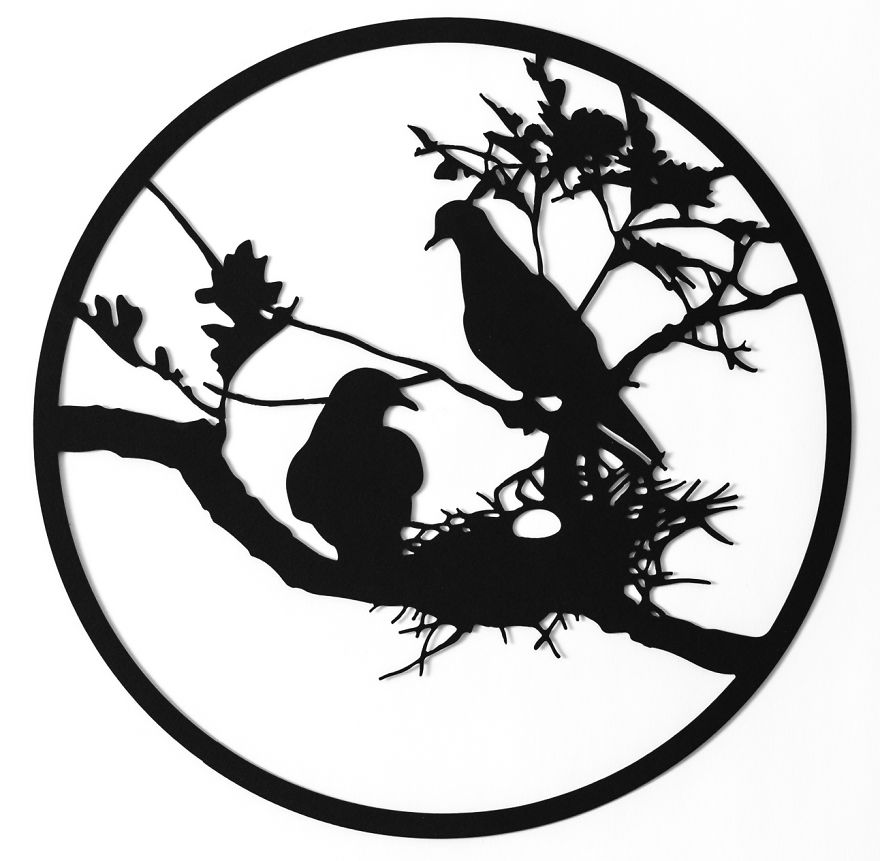Lonesome George, my new paper cutting series, is named after the last Galapagos Tortoise of its kind, who died in 2012. Like him, all the animals depicted here are extinct or in the process of going extinct, as a result of human activity.
Each paper cutting was cut from a single black sheet of paper.
Artwork was photographed by Revital Topiol.
More info: shiraglezerman.com
This post may include affiliate links.
Ivory Billed Wood Pecker (Critically Endangered)
The Ivory Billed Woodpecker is, or was, one of the largest members of the Woodpecker family, formerly common in the southeastern forests of the United States. Massive deforestation and hunting depleted its population to a point where it was considered extinct. In the 1920s a pair turned up in Florida, only to be shot for specimens. Though reports have indicated it has been seen again in the current century, they are unconfirmed. The species is currently listed as critically endangered and possibly extinct by the IUCN.
Western Black Rhino (Extinct)
Rhinos throughout Africa are constantly being hunted, both for trophy hunting and for their horn. The horn serves as a status symbol and as a fundamental ingredient in traditional Chinese medicine, believed to treat various diseases, from Typhoid to diabolic possession. The demand, along with the price, keeps rising. Horn poachers use tranquilizer guns to bring the rhinos down and cut their horn off, leaving the rhino to wake up and bleed to a slow, painful death. The poachers are often armed with guns supplied by international criminal organizations, making them very dangerous for the anti-poaching teams. Controlled, safe dehorning is one of the methods used in attempt to make them unattractive for poachers. This procedure is only partially effective because of its need to be repeated every two years due to the regrowth of the horn. Moreover, due to the horn's high price, hunters are willing to kill a rhinoceros even for a horn stump, and sometimes just for revenge. The Black West African rhinoceros was declared extinct by the IUCN in 2011. Other subspecies are mostly conserved in national conservative parks under the protection of the governments, in hopes to secure their survival.
Carolina Parakeet (Extinct)
The Carolina Parakeet was a very social north American bird. It was massively hunted for its beautiful feathers, for pet trade, to protect crops and for fun. When a flock member fell ill or died, many other Carolina Parakeets gathered around it, making the entire flock an easy target for hunters. Incas, the last Carolina parakeet, died in 1918 at the Cincinnati Zoo a few months after the death of Lady Jane, his lifelong mate.
Sumatran Tiger (Critically Endangered)
The Sumatran Tiger is endemic to the island of Sumatra and is hunted for its beautiful fur, bones and internal organs, commonly used in traditional Chinese medicine. It has been listed as critically endangered on the IUCN Red List in 2008, as the population in the wild is now estimated to be approximately 500 individuals, with a few more in Zoos throughout the world. The Sumatran Tiger is the last existing relative of a Bali tiger and the Javan tiger, both of which went extinct in the 20th century. Despite conservation efforts, the illegal hunting is still ongoing.
Formosan Clouded Leopard (Extinct)
The Formosan Clouded Leopard was endemic to the island of Taiwan, and was named after the beautiful cloud-like spots on its fur. Extensive logging of its natural habitat forced it to retreat into concentrated areas, making it easier for illegal hunters to reach them. Their fur, teeth and claws were used as decorations and souvenirs for tourists, and their bones and flesh for potions in traditional Chinese medicine. Live tigers were hunted for exotic pet trade. The last Formosan Clouded Leopard was seen in Taiwan in 1983. Two other subspecies of the Clouded Leopard still exist in Asia, declared VU (vulnerable) by the IUCN due to the ongoing illegal hunting.
Javan Tiger (Extinct)
The Javan Tiger used to live in the dense forests which once covered a quarter of the Indonesian island of Java. The increase in the island's human population led to massive deforestation, making room for coffee, rubber and teak plantations and rice fields. By 1975, the forests covered only 8 percent of the island. The last Javan Tiger was spotted in 1979.
Pyrenean Ibex (Extinct)
A combination of massive hunting, horn poaching, infections, diseases and other factors led to the point in which by the end of the 20th century, only one Pyrenean Ibex, Celia, remained. Celia was killed in 2000 by a fallen tree. Scientists used samples of blood and tissue taken from her body a year prior to her death, in order to clone several embryos, and implant them in surrogate goats. Only one pregnancy survived, and in January 2003 a baby Pyrenean Ibex was born, only to die of lung defects seven minutes later, thus becoming the first species in history to go extinct twice.
Passenger Pigeon (Extinct)
The Passenger Pigeon was an extremely social bird, very common in North America until the beginning of the 20th century. It lived in huge flocks, frequently described as being so dense they would blacken the sky. Together they flew, migrated, roosted and nested. This communally breeding bird nested in colonies which were so huge, they were called "cities", consisting of thousands of birds, sometimes hundreds on a single tree. The social lifestyle of this bird made it a convenient target for humans. Hunters would cut down nesting trees or set fire to the tree base, causing the adults to flee and the young to fall to the ground. Another method was burning sulfur beneath the nesting trees to suffocate the birds, which then plummeted to the ground, dazed and weak. Other hunters would blind a bird and tie it to a stool, to lure fellow birds to a trap. Originally the birds were hunted by Native Americans for food, but the European colonizers hunted them for sport as well, thus eliminating the Passenger Pigeon. Martha, the last Passenger Pigeon, died in the Cincinnati Zoo in 1914.
Seychelles Parakeet (Extinct)
The Seychelles Parakeet was endemic to the Seychelles. Its population declined radically due to heavy deforestation, which took place in order to clear land for agricultural needs. The remaining parakeets were hunted down by farmers to protect those fields. By the end of the 19th century, the Seychelles Parakeet had disappeared from the world.
It makes me so sad that these beautiful creatures were slaughtered by human greed. Here's to hoping we never repeat these mistakes!
It makes me so sad that these beautiful creatures were slaughtered by human greed. Here's to hoping we never repeat these mistakes!

 Dark Mode
Dark Mode 

 No fees, cancel anytime
No fees, cancel anytime 













































